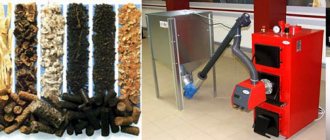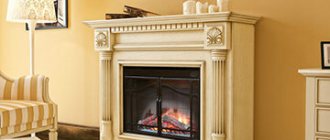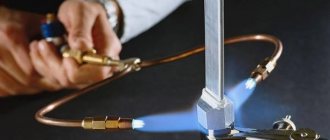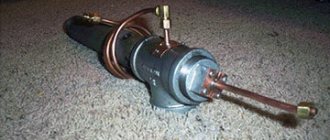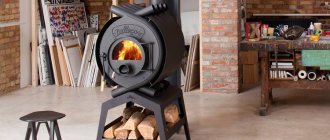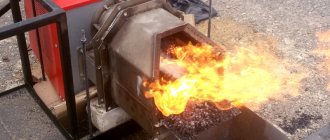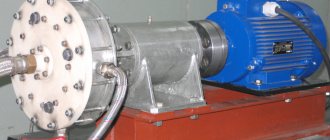In the process of manufacturing a biofireplace, it is necessary to make its most important element - the burner. The burner is the heart of the fireplace, since it responds to the presence of fire in the device. There should be no difficulties with the rest of the device. Let's look at how to make a burner for a bio-fireplace with your own hands.
Simple homemade bio fireplace
Pros and cons of biofireplace
Biofireplace has its advantages and disadvantages. The most significant of them.
Pros:
- easy to light and extinguish;
- does not require additional devices or power supply;
- this is an additional source of heat;
- safe combustion products.
Minuses:
- often the fire in the device is in an open structure, this is not always safe;
- the purchase will cost a decent amount;
- expensive fuel that burns quickly.
A desktop biofireplace may have an original design solution
Assembly instructions
Having collected the components for the bio-fireplace, you can begin assembling the device. Step-by-step instructions will allow you to assemble a biofireplace with your own hands without unnecessary difficulties:
The first thing we need to do is glue the glass protective screen. Silicone sealant dries in about a day, so the glass is joined in advance.
Making a Glass Protective Screen
Then you need to assemble, find, and make a metal frame in the form of a box in which the burner will be installed and on which you will place a protective screen.
Matching metal frame
Installing a protective screen
At the next stage, the burner is placed in the frame. If the fuel was sold in a tin can, then it could well play this role. If the container was plastic, you can use any tin can of a suitable size.
We place the burner in the frame
We place the wick in the jar, place it on the grid and cover it with decorative stones.
Preparing the metal mesh
Installing the mesh inside the frame on the burner
We cover the resulting structure with a protective screen, add decorative elements and the homemade bio-fireplace is ready.
Cover the mesh with decorative stones
Launching a bio-fireplace
Ecological handicraft fireplace
As you can see, creating an alcohol fireplace with your own hands is quite simple, but this is provided that it is small in size. For large-sized systems, the construction of a special portal will be required. The easiest way to build a structure is from plasterboard, an easy-to-use and inexpensive material. In this case, the procedure will be as follows:
- The first step is to prepare a platform for the biofireplace. It is necessary to protect the floor from high temperatures. You can make a screed on the floor or lay a brick.
- Then a bio-fireplace frame is built from a metal profile, which is securely attached to the floor and wall. Insulating material is placed inside the ceilings.
- The resulting structure is covered with plasterboard on the outside, and smoothed out with tiles or metal sheets on the inside. Fireproof materials will protect the plasterboard box from the harmful effects of fire.
Construction of a portal for an eco-fireplace
- From the outside, the box for the bio-fireplace is decorated in accordance with the interior of the room. The finishing with stone and plastic panels imitating brickwork looks great. Forged elements are also welcome, especially the corresponding accessories located next to the fireplace. You can put firewood next to the portal, and throw decorative ceramic replicas of firewood into the firebox of the bio-fireplace.
- A fuel unit is installed inside the resulting portal. If the system is massive, it is best to purchase a ready-made device in a store.
- To protect the external environment, a protective glass screen is installed on the fuel block.
The resulting bio-fireplace will undoubtedly become the main element of the room, and a real, living fire will allow you to create complete comfort in your home.
We hope that now you understand how to make a bio-fireplace at home. If you are quite ready to carry out the manipulations described above, create a bio-fireplace with your own hands, but if such work scares you, then just buy a ready-made device in a store. It is noteworthy that such devices are sold assembled, so you will not have any difficulties in starting the system. Read the instructions, turn on the device and enjoy a live fire.
Burner device for a biofireplace
The biofireplace consists of several elements. Each of them has certain requirements, which ensures safe operation of the device.
The main components of a biofireplace are the body, a protective metal grille and a fuel container.
Fuel container
The main element of a biofireplace is a container for fuel; it is made of metal. It doesn’t matter how it looks externally, it still won’t be noticeable. The main criterion is resistance to high temperatures and sealed joints so that fuel does not leak.
You can use a regular tin can as a container for fuel.
There should be at least 10 cm from the fuel container to the walls of the portal or housing. If the presence of several burners is implied, they are placed at some distance from each other, about 5-10 cm.
Frame
The body of the bio-fireplace must be made of heat-resistant material; it is advisable to treat it with paint that is resistant to high temperatures.
The biofireplace portal can be from:
- fireproof glass;
- metal;
- ceramics;
- marble.
Metal housing is one of the most common solutions
Fuel
The fire burns using bioethanol, an environmentally friendly liquid made from alcohol, which when burned emits only carbon dioxide and water. When using it, there is no unpleasant odor in the apartment.
Liquid fuel is obtained by processing agricultural crops, such as potatoes. Sometimes the fuel can be gel-like.
Fuel is usually available in large transparent bottles
500 ml of fuel lasts for 1.5 hours.
Important! Industrial alcohol cannot be used for bio-fireplaces. It will release sulfur vapors into the air, which are harmful to the body.
Wick
The inner and outer parts are connected by a wick. There are no special requirements for it; you can use a regular lace or a piece of fabric.
The wick for the fireplace can be ordinary twine
Metal grate
The metal grill allows you to evenly distribute heat over the entire area. It is also convenient to place decorative elements in the form of stones, shells, etc.
The metal grill can be ordered separately or made independently
Safety
Operating a biofireplace can be hazardous to health if a number of simple rules are not followed.
Precautionary measures:
- If the fireplace is large, it is better to install fireproof glass protection around it.
- The housing can be made of any heat-resistant material, usually a metal box.
- Fuel should only be added when the fireplace is in use. Alcohol-based liquid will still evaporate if left in the open air. Such regular fumes are not harmless.
- The fire should not be left unattended or placed near drafts or fans.
- When assembling the burner body, you should carefully check the tightness of the seams.
- The distance between flammable objects and the fireplace must be at least 1.5 m. Between other objects, at least 1 m.
What fuel should I use?
This type of fireplace should be fueled with bioethanol. The basis of this fuel is ethyl alcohol, but in addition to it there are also various additives.
Thanks to them, complete combustion of the mixture is ensured, so that the exhaust consists only of carbon dioxide and water vapor - substances that are absolutely safe for human health.
Therefore, a biofireplace does not require a smoke removal system; it is enough to simply ventilate the room.
It is prohibited to add gasoline, alcohol or other flammable liquids to bioethanol. The combustion products of homemade fuel can be toxic.
Types of burners for biofireplaces
Although biofireplaces differ in external parameters, their internal structure is almost the same.
There are only 3 types of burner devices:
- capillary;
- gravity;
- wick.
The standard biofireplace burner is simple in design
Capillary
A capillary burner requires the use of a precisely measured dose of fuel. It is drawn into the burner itself using capillary forces.
It has a number of disadvantages:
- While the evaporator is warming up, there is a smell of alcohol;
- at the beginning of combustion, the flame flares up strongly, but calms down after a few minutes;
- an excess of fuel provokes splashes, which can be dangerous at high temperatures;
- there is always some unspent fuel left in the capillary device;
- It is necessary to have a damper to regulate the fire;
- the filler has to be changed because it regularly becomes clogged with combustion products.
The simple design of the capillary burner can operate for up to 2 hours
Gravity
The fuel immediately enters the evaporator. Due to this, the fireplace is ignited immediately. The fire is kept stable, there is no need for a damper, but it is added to regulate the flame for decorative purposes. The design is quite complex and cannot be repeated on your own.
Fuel in a gravity-flow device is used to the end due to heating of the fuel tank
Wick
The wick burner evaporator is also a fuel tank that is heated by a flame. Refueling is carried out “by eye”; overfilling of fuel is not dangerous. The main thing is that the filler is completely saturated with fuel.
There is no need for a damper since the flame is stable.
A wick burner must have a metal grate to distribute heat
Important! Some commercial fireplaces operate from a wall outlet. This is due to the additional function of lighting, sounds, etc. The fire is always real, there is no urgent need for electricity.
Composition and features of biofuel
The “bio” part of the word “biofuel” explains that only natural, renewable raw materials are used to produce this substance. Therefore, it is completely environmentally friendly and biodegradable.
The main components used to produce such fuel are grasses and grains containing large amounts of starch and sugar. Thus, corn and cane are considered the best raw materials.
You can find various brands of biofuels on sale. Preference should be given to certified products, otherwise you may face serious troubles
They produce bioethanol, or a type of alcohol. It is a colorless liquid and has no odor. If necessary, it can replace gasoline, however, the cost of such a substitute is much higher. When burned, pure bioethanol decomposes into water in the form of vapor and carbon dioxide.
In this way, it is even possible to humidify the air in the room where the bio-fireplace is installed. The substance burns with the formation of a blue “gas” flame.
This is a purely aesthetic drawback that prevents you from still enjoying the sight of an open fire. A traditional fireplace produces a yellow-orange flame, which is a kind of standard. To eliminate this drawback, additives are introduced into biofuels that change the color of the flame.
Thus, the traditional composition of a flammable liquid is as follows:
- bioethanol – about 95%;
- methyl ethyl ketone, denaturing substance – about 1%;
- distilled water - about 4%.
In addition, crystalline bitrex is added to the fuel composition. This powder has an extremely bitter taste and is intended to prevent alcohol biofuels from being consumed as alcohol. Biofuel is produced in different brands, its composition may vary somewhat, but in general does not change. It is clear that the cost of such fuel is quite high.
It is not recommended to use homemade fuel for biofireplaces, but if you still decide to try, to make it you need to use only high-purity gasoline “Galosha”
Fuel consumption depends on the number of burners and the power of the biofireplace. On average, a 2-3 hour operation of a heating unit with a power of about 4 kW per hour consumes about a liter of flammable liquid. In general, operating a biofireplace turns out to be quite expensive, so home craftsmen are trying to find a cheaper alternative to fuel. There is such an option and it is viable.
To avoid trouble, you need to purchase only high-quality components for homemade fuel. We must not forget that the bio-fireplace does not have a smoke exhaust, and all combustion products immediately enter directly into the room.
If toxic substances are present in the fuel, and this is not uncommon for low-quality alcohol-containing compounds, they will end up in the room. This threatens with the most unpleasant consequences. We recommend that you familiarize yourself with the best biofuel brands.
Therefore, it is not recommended to make fuel for a biofireplace yourself. However, if you really want to experiment, this is the safest recipe. Take pure medical alcohol. It must be purchased at a pharmacy.
To color the flame, highly purified gasoline is added to it, which is used to refill lighters (“Galoshes”).
Filling the fuel tank must be done very carefully. If liquid is spilled, you must immediately wipe it with a dry cloth, otherwise an accidental fire may occur. Liquids are measured and mixed
Alcohol should be present in a volume of 90 to 94% of the total amount of fuel, gasoline can account for 6 to 10%. The optimal proportion is determined empirically, but you should not go beyond the recommended values. Detailed instructions for the production and use of biofuel are given here
Liquids are measured and mixed. Alcohol should be present in a volume of 90 to 94% of the total amount of fuel, gasoline can account for 6 to 10%. The optimal proportion is determined empirically, but you should not go beyond the recommended values. Detailed instructions for the production and use of biofuel are given here.
It is important to remember that the resulting fuel cannot be stored, since the mixture of gasoline and alcohol will separate. It should be prepared before use and shake well for better mixing.
Types of biofireplaces
Before you start designing a biofireplace, you should figure out where it will be located and what function it will perform.
Biofireplaces are:
- desktop; Compact devices do not take up much space
- wall; A wall-mounted fireplace will fit harmoniously into the living room
- floor Floor-standing device ideal for large rooms
Tabletop fireplaces are usually small in size, round or rectangular in shape, made of ceramic or metal. The distance from the glass to the burner should not be less than 10 cm.
Wall-mounted fireplaces always have an elongated rectangular shape so that they can be easily attached to the wall. The back wall is always made of heat-resistant material, such as metal. The front part is made of fireproof glass.
Floor biofireplaces are the largest. They are often made decoratively like standard fireplaces with a chimney. If this is an ordinary bio-fireplace, it is simply installed on the podium.
The necessary conditions
Burner for a bio-fireplace
A drawing of a burner for a bio-fireplace of varying complexity can be easily found on the Internet. And it won’t be difficult to draw it yourself either. However, before you start working, you need to understand that there are some requirements for the device that must be met in order for the craft to turn out not only beautiful and stylish, but also safe.
- You shouldn't save money by using cheap material - this is not an option. Fire is a very insidious element, capable of getting out of control even with the slightest inaccuracy.
- The ideal, and practically the only solution would be to use a thick-walled sheet of stainless steel, from which to cut out the necessary parts, and then hermetically connect them.
- Do not rush and wait the required time for the fastening components to harden or dry.
- After completion of work and before first use, carefully check for any unevenness, scratches or chips.
The conditions are not difficult, but their implementation will ensure not only beauty and comfort, but also safety.
How to make a burner for a biofireplace with your own hands
A burner for a bio-fireplace, the drawing of which must be drawn taking into account all dimensions, is assembled from a tin can, a body and a wick. Next, if desired, install a metal grate, mineral wool, fireproof glass, etc.
Drawings of the body of biofireplaces of wick, capillary and gravity type will help you assemble the devices yourself
Important! You cannot make fuel yourself; combining combustible elements can lead to unpredictable reactions.
Simple burner
The simplest option is a tin can burner. Bioethanol is poured into the container. For better heat distribution, you can put a metal grate and put stones on it for beauty. The area above the hole is set on fire.
It would be good if the fireplace body was metal with double walls.
The simplest burners resemble a tin can
Burner with filler
The operating method is similar to a simple burner, but mineral wool or glass wool is used as a filler. The best option is white glass wool on an acrylic base; it absorbs liquid well and easily allows vapor to pass through.
When filling the container, the cotton wool should not be compacted; it should be placed freely in the container. A metal mesh is installed on top, then fuel is poured. Cotton wool quickly absorbs bioethanol and prolongs its burning time.
Burners for a biofireplace with mineral wool are one of the options for a more complex design
Preparing to make a biofireplace
To make your own fireplace, you first need to decide on its type, take the necessary measurements, and make a sketch of the future model. This will allow you to avoid errors during work.
Materials and tools
You can make a bio-fireplace at home using ordinary glass, for example, from an A4 photo frame, a glass cutter, silicone sealant, metal mesh, a mesh from a barbecue or oven, a metal box, pebbles or other heat-resistant stone, fuel and wick.
Do-it-yourself desktop biofireplace
The stages of its construction are as follows:
- We calculate the distance between the burner and the protective screen. It should exceed 15 cm to avoid damage to the glass. We measure the distance between the burners - it should be more than 16 square meters. cm.
- Preparing the fuel tank. You can use a simple square or rectangular metal box, keeping in mind the distance from the flame to the glass.
- Painting the drawer to increase its aesthetics. It is carried out only from the outside, as fire or release of toxic substances from the paint applied to the inner surface is possible.
- Creation of a protective glass casing. It can be made from ordinary three-millimeter glass or 4 glasses from a photo frame, which are adjusted to fit the metal box.
- The glass is glued together with silicone sealant, secured between supports, which can be any stationary objects, and left in this state for a day until the sealant dries.
- Excess sealant is removed with a blade.
- Biofuel preparation. Only a metal can is suitable for storing it, even if it was sold in a plastic one. The jar is placed at the bottom of the box. One standard container of fuel will support combustion for several hours, after which it will need to be replaced - you will need to remove the stones and mesh or fill in a new portion with a large syringe.
- Cutting a mesh to cover the box. This can be done in two layers. Its fastening will be more reliable if you use wire, but do not forget that the mesh must be removed to replace the can of fuel.
- Laying stones on the grid. They are needed not only as a decorative element, but also for uniform heat distribution between the grille and the screen.
- Ignition of a biofireplace with a torch lowered through a mesh into a container with fuel.
Do-it-yourself floor biofireplace
To design a floor biofireplace you need:
- Prepare materials: a sheet of drywall, 2 square meters of thermal insulation material, 2 square meters of tiles with glue, 8-9 meters of metal profile, a hundred screws and self-tapping screws, grout, stones or other decorative elements, heating unit.
- Assembling the frame using screws and a metal profile.
- Sheathing the frame with plasterboard and self-tapping screws, two layers on each wall, between which glass wool or other thermal insulation will need to be placed.
- Facing with tiles or other similar material. To do this, you need to carefully lay it out in accordance with the idea; for example, the fireplace can be made monochromatic or a pattern can be added.
- Grouting joints.
- Drying.
- Installing the heating unit in its place.
DIY bio-fireplace burner
The most reliable material for a burner is stainless steel. Its walls should be thick enough to avoid deformation when heated. You should also be very careful when assembling, since unreliable fastening or a defect will damage the bio-fireplace.
It is advisable that the burner be solid, so there is less chance that fuel will spill out. A paint can is best suited for this role, the main thing is to make sure that its size is suitable for the fireplace and that there are no cracks or holes in it.
Those who are not looking for easy ways can make the burner completely themselves; it is not difficult, since in appearance it looks like a large matchbox with an oblong hole in the top for pouring biofuel. Sheets of metal 1.5-2 mm thick are welded at the seams. You can add glass wool to it, which acts as a wick, and a damper, which will regulate the flame and extinguish it.
The burner is ignited with an ordinary wick, for example, a cord dipped into biofuel, the end of which will rise above the stones or other decorative elements.
Fuel for biofireplace
Bioethanol can be used as a fuel; it is sold in specialized stores, but can also be made at home, since it consists of gasoline, which is used to fill lighters, and ordinary medical alcohol, mixed 1 to 9. After mixing and shaking, the mixture is suitable for use.
Decorating a burner for a biofireplace
Decorations neatly hide the burner elements and help turn an ordinary fireplace into a stylish piece of furniture.
Decoration materials:
- any natural stones, pebbles;
- ceramic dummies of logs;
- shells;
- dummies of glass ceramic coals.
Decorative elements depend on the interior in which the fireplace will be located.
For rooms with a light interior, a combination of shells and white round stones is suitable.
A fireplace decorated with white stones is suitable for a living room in Art Nouveau style
For a classic living room, it is better to choose imitation logs or coals. Most often, the fireplace is decorated with various natural stones.
Imitation of a fireplace with a chimney
The imitation of a real fireplace with a portal is very popular. This burner design for a bio-fireplace will not differ from a conventional tin can design.
The portal is made of plasterboard and metal profiles. Painting is carried out with acrylic dye with mineral pigment. The vault must be treated with heat-resistant enamel, this will protect it from fire.
Such portals still have a risk of ignition; when using a biofireplace, you should not move away from the structure.
Tips for making
In fact, this is an ordinary container in which biofuel is burned. Anyone can make such a design, but you should remember a few things when doing it. Before starting work, it is worth making a drawing of the fireplace and a drawing of the burner for the bio-fireplace.
Attention! You should always remember that this design has no exhaust, which leads to heating of nearby elements. Therefore, pay special attention to fire safety measures. Never leave the fireplace running.
- The frame can be made from any material. It is possible to make it from a metal profile and cover it with tiles. It all depends on your desire;
Approximate drawing of the burner
- The structure can be made of any sheet metal.
Attention! If you are cutting sheet metal, then it is better to use a grinder with a cutting wheel. It is also possible to use scissors, but it is quite difficult to make a right angle with them when cutting. The metal may bite, causing the container to become leaky. But this cannot be allowed.
- If you have a glass fireplace, then use fireproof material. However, it is more expensive than the traditional one. When using ordinary glass, ensure the distance from the fire to the body: it must be sufficient, otherwise the glass will heat up and burst.
- If a plastic casing is used, please note that the burner device for a biofireplace must be made of metal.
- Try to achieve the most uniform distribution of heat; to do this, you can cover the burner with a metal mesh. It will cut the flame and distribute it more evenly.
- To make a wick, you can use an ordinary cord. One of its edges is lowered into the fuel, and the second is released between stones or other decorative elements.
Follow the manufacturing tips and take the time to make a drawing first. This way, your product will please the eye for a long time and will not cause any hassle.
We make a biofireplace for the home with our own hands: wall-mounted, floor-mounted, table-top
For most of us, a fireplace is a symbol of warmth and comfort. True, it is unrealistic to equip it within the walls of an ordinary apartment in the city for technical reasons. However, this is not a reason to be sad, because in practical conditions it can be replaced with a bio-fireplace - an environmentally friendly device that creates a live fire without smoke and ash. This option does not require the construction of a chimney and is very easy to assemble with your own hands.
Making a tabletop bio-fireplace for living space
The desktop version is actively used in interior design
The desktop version is considered completely non-hazardous and stands out for its beautiful appearance, therefore it is most often used in interior design. Moreover, its construction requires a minimum of effort and money.
Required materials and materials
- steel mesh made of metal, construction or for barbecue;
- glass sheet 3 mm thick;
- metal box;
- silicone based sealant;
- wick cord;
- glass cutter;
- biological fuel - it is available at special points of sale;
- decor if needed.
The dimensions of the future bio-fireplace depend entirely on the wishes of its owner. The main thing is to make the correct calculations when selecting them. The distance from the burner to the glass must be more than 15 cm, otherwise the glass screen will burst. You can install several burners in a biofireplace. Their number is calculated at the rate of 1 burner per 16 m2 of area.
Preparation work
A complicated method of manufacturing a tabletop biofireplace takes into account the purchase of a burner and its further fastening between 2 glasses
At this step, you need to make glass blanks according to the dimensions of the fuel tank. The final one must be purchased or made without outside help from an ordinary metal box of a rectangular or square shape. The dimensions of the desktop biofireplace itself can be calculated individually or you can use a ready-made drawing. It must be remembered that the length of its side determines how far the flame will be located from the glass.
Detailed manufacturing instructions
The process takes into account a couple of stages, including the assembly of fuel and glass blocks, decor
- Construction of a fuel block. To do this, the finished iron box is painted on the outside. It is prohibited to cover it with anything inside, as toxic substances will be released during the combustion process.
- Connecting glass blanks using sealant. After applying it, all parts must be fixed between supports or any stationary objects, leaving in this form for a day until it dries completely.
- Remove excess sealant using a blade. This stage is beautiful and can be omitted if necessary.
- Preparation of biological fuel. For safety, it should be placed in an iron can, which is subsequently located at the bottom of a metal block. Then it can be changed as the liquid burns out.
- Making a lid for a box from a metal mesh. It is cut to the size of the box and, depending on the size of the cells, is laid in 1 or 2 layers. For greater reliability, it is attached with wire, and then the fuel is changed using an ordinary syringe.
- Laying artificial stones or pebbles on the mesh, which will also provide equal heat distribution. Additional decoration of the bio-fireplace if desired.
For safety, it is better to light a bio-fireplace with a torch.
Manufacturing - detailed instructions with photos
To make a primitive fuel block for a biofireplace with your own hands, which will not require any additional design, you need to prepare:
- a wide vessel made of heat-resistant glass (a similar one is sold among kitchen utensils);
- an empty tin of drinks or beer;
- a little bit of basalt wool insulation;
- very small and medium artificial stones.
To begin, place the jar in a bowl, mark a line along the height of its side and cut it with a utility knife.
Then drill the bottom of the can in 3-4 places, place basalt fiber tightly in the middle and insert one half into the other, as shown in the photo.
Place the improvised burner in a glass vessel and cover it nicely with stones and shells. Pour fuel into the can through the holes and set it on fire. You can use medical alcohol for testing. How such a handmade bio-fireplace burns can be seen in the following photo:
The production process is shown in detail in the video:
If there is an inverter-type device in the house that you can use, you can make the container from stainless steel, and then fix it between two thick glasses, as shown in the drawing.
To make a linear version of the burner, you need to take a profile stainless steel pipe with a cross-section of 4 x 4 cm and a wall thickness of 2 mm. Then cut off a corner along its entire length and make cross-shaped slits on the edge with an angle grinder.
Next, hermetically weld the corner to the cut-off area on the pipe, turning it edge down so that a depression emerges. Fill the internal cavity of the burner tightly with non-flammable basalt thermal insulation, and then weld the ends.
The final step is making a frame for your fuel block. Cut a frame from thin metal and carefully grip it to the burner. Then fill the latter with ethanol (aka ethyl alcohol) and set it on fire.
You can attach legs to the finished fuel cell, or better yet, build it into a fireplace portal or a painted metal body that can be hung on the wall. An example of such a box is shown in the drawing.
